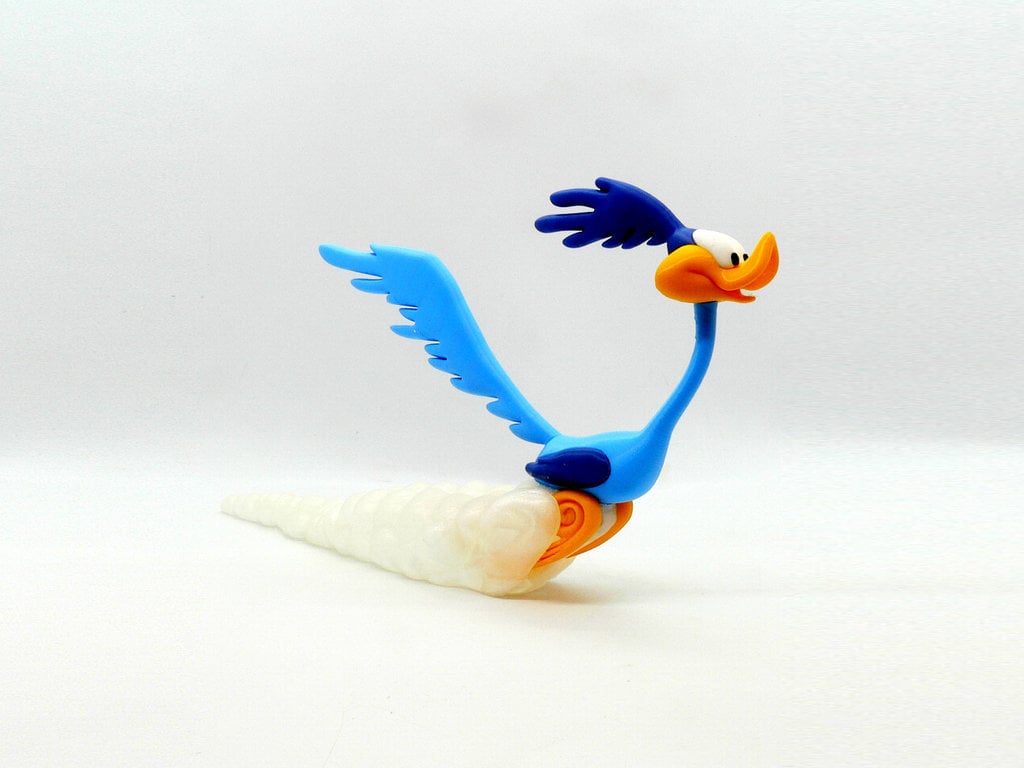
Road Runner
thingiverse
Road Runner, a cartoon character in the Looney Tunes and Merrie Melodies series of short films produced by Warner Bros. Road Runner, also known as Beep Beep, speaks only with a signature "beep beep" (sometimes misheard as "meep-meep") noise and an occasional "popping-cork" tongue noise. His nemesis, Wile E. Coyote, utilizes absurdly complex gizmos and elaborate plans to try to catch him, but fails every time. No supports are required. One piece contains built-in supports and one piece contains built-in braces. Optional parts without the built-in supports/braces are also supplied if you want to use your slicer supports (see notes below). If you have the proper filament colors, no painting is needed. The assembled model is 155mm tall, 280mm long, and is in proportion to my previously released Wile E. Coyote model. Enjoy! ........................................................................................................... Special shoutout to maker Benoît Lussier for providing QA printing and quality feedback. ........................................................................................................... **Print Instructions:** Supports: No Resolution: .2mm Infill: 10% (see optional special considerations for the dust) Notes:** Refer to the notes below for a few helpful printing and assembly instructions. ........................................................................................................... **Building the model** Colors Black: (Paramount3D PLA - Black) eye_black_right eye_black_left .. Yellow: (Paramount3DPLA - Egg Yolk Yellow) beak beak_without_supports (optional piece) foot_left foot_right .. Dark Blue: (Parmount3d PLA - Cadet Blue) head wing_left wing_right .. White: (Overture PLA - White) eye_white_left eye_white_right .. Light Blue: (3DSolutech PLA - Aqua Blue) body tail tail_without_braces (optional piece) .. Transparent: (Bumat ABS - Transparent) (see notes for filament options for this part) dust ........................................................................................................... **Printing and assembly tips** Printing tips 1 - No supports are required. One piece contains built-in supports, beak, and one piece contains built-in braces, tail. Optional parts without the built-in supports/braces are also supplied if you want to use your slicer supports. The built-in supports are designed for a .4mm nozzle (be sure you do not set your slicer for 'thick bridges') and for the size that the model is presented. Use your discretion for which parts to use if you resize the model significantly. 2 - There are some pieces that may need brims or rafts, use your discretion. When setting up my prints I prefer to be conservative to ensure the least chance of a print failure, especially since the base of many parts are hidden when inserted into another part. *I used brims on: (no parts required brims or rafts) 3 - The eye_black parts are the only parts that are very small. It may be wise to print extra copies in case you drop them. 4 - When removing parts from the printer bed, it's a **VERY** good idea to place left/right parts into separate containers to help with the assembly process. Sometimes the difference between the left and right parts is very small but it is still worth keeping track of them and assembling them in their proper place. 5 - I just happened to have a transparent ABS on hand, so I used it for this model. I did try a crystal clear filament and personally felt that even though the legs were more visable, the rest of the dust did not look as good. In addition, the feet stick out enough that an opaque filament might still look good for this model. 6 - For transparency in the dust for the feet to show through, I used the 'lightning' infill pattern at 10% infill. .. Assembly tips: 1 - Take your time gluing the model together and enjoy the process. Give some thought into which parts to glue together as groups and then gluing the groups together. Let the glue for each group set completely before combining groups. 2 - I used 3D Gloop and E6000 to put this model together. I am not affiliated with 3D Gloop but have experimented with different glues for my models and have found that this glue is a great option for my models. Each type of glue has different pros/cons and I found that 3D Gloop was far easier to use than superglue (for me). The E6000 sticky glue that I also use allows more time to position parts and is still the best for smaller parts. 3D Gloop covers the middle ground for me and really works wonders. It leaves enough time to set, so parts can be positioned correctly and it dries fast enough to hold awkward parts without the need for taping. I used the PLA version that comes in a tube. For both glues using a smaller amount is usually better than more glue. 3 - The eye_blacks should be inserted into the eye_whites before putting the eye_whites into the head/beak assembly. 4 - The neck to head connection is not as convenient as I would have liked due to the shape of the parts. I glued all the head parts together and glued all the rest of the parts together. Once the glue on both sections were fully set, I then joined the head to the body using 3dGloop. A fast drying glue is preferable for this joint. 5 - Benoit glued the feet to the body and inserted the combined part with a rotation to follow the opening in the dust. No need of glue. 6 - Refer to the assembly diagrams in the pictures section as well as the uploaded pictures for putting the model together. The model is meant to be glued. Do not hesitate to ask questions, feedback is essential to making better models.
With this file you will be able to print Road Runner with your 3D printer. Click on the button and save the file on your computer to work, edit or customize your design. You can also find more 3D designs for printers on Road Runner.
